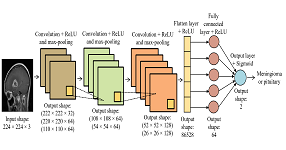A Convolutional Neural Network for Automatic Brain Tumor Detection
DOI:
https://doi.org/10.46604/peti.2023.10307Keywords:
artificial intelligence, MRI, convolutional neural network, brain tumorsAbstract
Magnetic resonance imaging (MRI) combined with artificial intelligence (AI) algorithms to detect brain tumors is one of the important medical applications. In this study, a Convolutional neural network (CNN) model is proposed to detect meningioma and pituitary, which was tested with a dataset consisting of two categories of tumors with 1,800 MRI images from several persons. The CNN model is trained via a Python library, namely TensorFlow, with an automatic tuning approach to obtain the highest testing accuracy of tumor detection. The CNN model used Python programming language in Google Colab to detect sensitivity, precision, the area under the PR and receiver operating characteristic (ROC), error matrix, and accuracy. The results show that the proposed CNN model has a high performance in the detection of brain tumors. It achieves an accuracy of 95.78% and a weighted average precision of 95.82%.
References
H. H. Sultan, N. M. Salem, and W. Al-Atabany, “Multi-Classification of Brain Tumor Images Using Deep Neural Network,” IEEE Access, vol. 7, pp. 69215-69225, 2019.
M. B. Naceur, M. Akil, R. Saouli, and R. Kachouri, “Fully Automatic Brain Tumor Segmentation with Deep Learning-Based Selective Attention Using Overlapping Patches and Multi-Class Weighted Cross-Entropy,” Medical Image Analysis, vol. 63, article no. 101692, July 2020.
H. Mzoughi, I. Njeh, M. B. Slima, and A. B. Hamida, “Review of Computer Aided-Diagnosis (CAD) Systems for MRI Gliomas Brain Tumors Explorations Based on Machine Learning and Deep Learning,” 6th International Conference on Advanced Technologies for Signal and Image Processing, pp. 1-6, May 2022.
S. Bauer, R. Wiest, L. P. Nolte, and M. Reyes, “A Survey of MRI-Based Medical Image Analysis for Brain Tumor Studies,” Physics in Medicine & Biology, vol. 58, no. 13, pp. R97-R129, July 2013.
M. Pantoja, M. Weyrich, and G. Fernández-Escribano, “Acceleration of MRI Analysis Using Multicore and Manycore Paradigms,” The Journal of Supercomputing, vol. 76, no. 11, pp. 8679-8690, November 2020.
Q. T. Ostrom, H. Gittleman, G. Truitt, A. Boscia, C. Kruchko, and J. S. Barnholtz-Sloan, “CBTRUS Statistical Report: Primary Brain and Other Central Nervous System Tumors Diagnosed in the United States in 2011–2015,” Neuro-Oncology, vol. 20, no. suppl_4, pp. iv1-iv86, October 2018.
S. Mohsen, A. Elkaseer, and S. G. Scholz, “Human Activity Recognition Using K-Nearest Neighbor Machine Learning Algorithm,” Proceedings of the International Conference on Sustainable Design and Manufacturing (KES-SDM 2021), Smart Innovation, Systems and Technologies, vol, 262, pp. 304-313, September 2021.
P. Afshar, A. Mohammadi, and K. N. Plataniotis, “Brain Tumor Type Classification via Capsule Networks,” 25th IEEE International Conference on Image Processing, pp. 3129-3133, October 2018.
A. K. Anaraki, M. Ayati, and F. Kazemi, “Magnetic Resonance Imaging-Based Brain Tumor Grades Classification and Grading via Convolutional Neural Networks and Genetic Algorithms,” Biocybernetics and Biomedical Engineering, vol. 39, no. 1, pp. 63-74, January-March 2019.
P. Saxena, A. Maheshwari, S. Tayal, and M. Saumil, “Predictive Modeling of Brain Tumor: A Deep Learning Approach,” Computer Vision and Pattern Recognition, November 2019. https://arxiv.org/abs/1911.02265
Y. Zhou, Z. Li, H. Zhu, C. Chen, M. Gao, K. Xu, et al., “Holistic Brain Tumor Screening and Classification Based on Densenet and Recurrent Neural Network,” International MICCAI Brainlesion Workshop, Brainlesion: Glioma, Multiple Sclerosis, Stroke and Traumatic Brain Injuries, Lecture Notes in Computer Science, vol. 11383, pp. 208-217, January 2019.
J. Cheng, W. Huang, S. Cao, R. Yang, W. Yang, Z. Yun, et al., “Enhanced Performance of Brain Tumor Classification via Tumor Region Augmentation and Partition,” PLoS ONE, vol. 10, no. 10, article no. e0140381, October 2015.
N. Abiwinanda, M. Hanif, S. T. Hesaputra, A. Handayani, and T. R. Mengko, “Brain Tumor Classification Using Convolutional Neural Network,” World Congress on Medical Physics and Biomedical Engineering 2018, vol. 68/1, pp. 183-189, May 2018.
K. Kaplan, Y. Kaya, M. Kuncan, and H. M. Ertunç, “Brain Tumor Classification Using Modified Local Binary Patterns (LBP) Feature Extraction Methods,” Medical Hypotheses, vol. 139, article no. 109696, June 2020.
A. Pashaei, H. Sajedi, and N. Jazayeri, “Brain Tumor Classification via Convolutional Neural Network and Extreme Learning Machines,” 8th International Conference on Computer and Knowledge Engineering, pp. 314-319, October 2018.
E. I. Zacharaki, S. Wang, S. Chawla, D. S. Yoo, R. Wolf, E. R. Melhem, et al., “Classification of Brain Tumor Type and Grade Using MRI Texture and Shape in a Machine Learning Scheme,” Magnetic Resonance in Medicine, vol. 62, no. 6, pp. 1609-1618, December 2009.
J. Xiong, K. Zhang, and H. Zhang, “A Vibrating Mechanism to Prevent Neural Networks from Overfitting,” 15th International Wireless Communications & Mobile Computing Conference, pp. 1737-1742, June 2019.
D. P. Kingma and J. Ba, “Adam: A Method for Stochastic Optimization,” 3rd International Conference for Learning Representations, May 2015. https://doi.org/10.48550/arXiv.1412.6980
“Brain Tumor Datasets,” https://www.kaggle.com/datasets/drsaeedmohsen/googledrive, December 15, 2022.
S. Mohsen, A. Elkaseer, and S. G. Scholz, “Industry 4.0-Oriented Deep Learning Models for Human Activity Recognition,” IEEE Access, vol. 9, pp. 150508-150521, 2021.

Published
How to Cite
Issue
Section
License
Submission of a manuscript implies: that the work described has not been published before that it is not under consideration for publication elsewhere; that if and when the manuscript is accepted for publication. Authors can retain copyright of their article with no restrictions. Also, author can post the final, peer-reviewed manuscript version (postprint) to any repository or website.

Since Oct. 01, 2015, PETI will publish new articles with Creative Commons Attribution Non-Commercial License, under The Creative Commons Attribution Non-Commercial 4.0 International (CC BY-NC 4.0) License.
The Creative Commons Attribution Non-Commercial (CC-BY-NC) License permits use, distribution and reproduction in any medium, provided the original work is properly cited and is not used for commercial purposes







